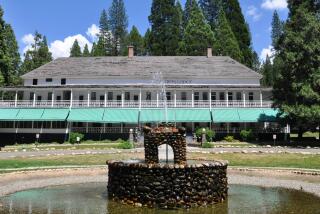Hotel Restoration Becomes a Worldwide Trend
- Share via
In the unforgiving economic climate of the travel industry, one item has apparently outpaced all others--the construction costs of hotels. On the average, it costs a staggering $200,000 per room to build a hotel.
As a result, many hoteliers are looking at their existing properties and making a wise decision.
They are lovingly restoring the hotels.
For the owners, the cost of restoring and renovating their hotels is often less than half the cost of building new ones. And for guests, the return of the grand hotels can be a definite plus: larger guest rooms and bathrooms, more thoughtful design, thicker walls, and last but not least, a distinct sense of history and charm.
Throughout the United States a growing number of historic hotels are being restored. Lincoln Hotels Corp. has specialized in refurbishing some grand old hotels in San Antonio; Little Rock, Ark.; St. Paul, Minn., and Philadephia.
Part of Renovation
In St. Louis the 550-room Omni International hotel is brand new, but it was built as part of the city’s $140-million Union Station renovation. The hotel’s lobby is the depot’s wonderfully restored Grand Hall, with carved ceilings.
The Equinox, a 216-year-old resort hotel (and national landmark) in Manchester Village, Vt., that had been falling apart for 13 years was lovingly restored to a tune of $20 million.
Texas can boast substantial hotel restoration. San Antonio has five beautifully restored hotels. Dallas has three. And Galveston boasts hotels such as the Tremont House (a 19th-Century counting house).
In Seattle, extensive work has been done to restore the 76-room Sorrento hotel. And part of the once tumbledown waterfront has been turned into the Alexis Hotel. Perhaps the most extensive restoration in Seattle belongs to the Olympic, a 62-year-old landmark brought back to life with a $60-million restoration.
In Hawaii, Sheraton has tried to keep the old pink palace, the 166-room Royal Hawaiian, the way it was with a $4-million face lift. Built in 1927, the hotel retains much of its original wicker furniture and room design.
Each Room Photographed
“We have so many repeat guests here,” spokeswoman Barbara Sheehan said, “that they want the rooms to be exactly the same.” As a result, the hotel’s housekeeping department has photographed each room. When repeat guests arrive again, their favorite furniture is moved back to the room.
Perhaps the strongest commitment to hotel restoration is at some Inter-Continental hotels. In Australia the company is restoring Sydney’s landmark Treasury buildings as a 545-room hotel. In France the company restored the 108-year-old Continental Hotel in Paris (now the Inter-Continental).
The most challenging (if not expensive) restoration has been to Washington’s Willard Hotel, which celebrates its grand reopening this week.
The hotel had been closed for 18 years. It was built in 1901 and soon became known as the “hotel of presidents.” The hotel unceremoniously closed July 15, 1968.
Now, Inter-Continental has invested a near-record $120 million to bring the Willard back to its original style and grace, and virtually everything in the huge building has been restored to its original condition.
Overseas Projects
Hotel restoration work is just as active overseas.
Many of the older hotels in England were poorly designed buildings. Rooms were small, bathrooms smaller. They were poorly heated in winter. In summer, air conditioning was non-existent.
As more Americans visited the United Kingdom and complained about their accommodations, British hoteliers were faced with a choice: to build new buildings or renovate the existing properties. They chose the latter.
In doing so, they fought to maintain the little things about each hotel that made for good travel experiences.
The Mayfair Hotel in London spent $15 million on its restoration. The project included enlarging guest bedrooms and installing central air conditioning. It also included keeping the original water-heated towel racks in each bathroom.
“We discovered a number of things hidden under false ceilings,” reported the general manager, Patrick Board, “including a fantastic old chandelier that had always been in the lobby but we never knew it.”
Piccadilly’s New Look
In 1908 the 296-room Piccadilly was the hotel in London. Two years ago, tired and shabby, it catered to discount tour groups and the occasional tourist who couldn’t find a room elsewhere.
In 1983, the hotel was acquired by Gleneagles Hotels. It underwent a $22.4-million top-to-bottom restoration and changed its name to the New Piccadilly.
The beautiful Australian oak paneling was stripped of paint to expose the grain of the wood. Venetian chandeliers were regilded. Heated towel racks in guest bathrooms were repaired.
The only new--and necessary--touches: All windows were double-glazed for insulation in winter, and air conditioning was added for summer.
In Scotland the restoration of the legendary Gleneagles Hotel began in 1981 and was recently completed. It was a total refurbishing of the property, costing $10.5 million.
Working Fireplaces
The hotel added 50 rooms, but kept many traditions. Many of the wood-burning fireplaces in the guest rooms were kept in working order. “We have longtime guests,” said the general manager, Peter Lederer, “who want them lit, even on a summer’s evening.”
Lederer found antique chairs in the hotel’s storage area and restored them. “We even found a beautiful old upright Steinway piano,” he said. A domed skylight was discovered hidden above a false ceiling. The ceiling was removed.
And the hotel’s trademark wooden revolving doors had long since disappeared, replaced by an ugly single double door. Lederer spent $60,000 for another custom-made wooden-and-brass revolving door.
In Madrid the venerable 76-year-old Ritz Hotel just completed a three-year, $12-million restoration. In Ireland, the famed 18th-Century Ashford Castle, a most unusual resort and the home of the Guinness family for more than 100 years, has been restored to the tune of $7.6 million.
L.A. Restorations
Millions have been spent on restoring two Los Angeles landmarks. The Biltmore Hotel has become a design and architectural landmark. Despite its location downtown, a growing number of guests choose to stay there.
On the other hand, there’s the Hollywood Roosevelt Hotel. While the public rooms have been exquisitely restored, many of the guest rooms remain small. And the neighborhood surrounding the hotel has not been similarly upgraded.
But when you start out with a great location, restoration can only mean great things. In Bermuda, Club Med bought a typical high-rise resort hotel. It had been a Holiday Inn, then a Loews Hotel. The folks at Club Med have invested millions and turned St. George’s Cove into something special.
They have renovated the entire original hotel, but more important, under the auspices of the Maritime Museum of Bermuda, Club Med concentrated on the 65 acres surrounding the original hotel building, and restored the old British installations at Ft. Albert and Ft. Victoria as well as the nearby parade grounds.
U.S. Chains Involved
Some large American chains have also gotten into the hotel restoration game. Marriott, Best Western and Hyatt have invested millions in restoring some of their overseas properties.
Marriott just completed a $60-million renovation and recently reopened the 55-year-old Castle Harbour Resort seven miles from Hamilton, Bermuda.
And, in Manchester, England, the aging Midland Hotel is being brought back to life by none other than Holiday Inn. The original property, built in 1903, was constructed in the high style of provincial Edwardian baroque.
Sheraton has spent more than $6 million in a total less-is-better renovation of its Belgravia property in London. Before the project the hotel had 120 rooms. It now has 89.
The 210-room Peninsula in Hong Kong is one of the great hotel legends of Asia. But most who have stayed there recently would agree that the hotel is in need of restoration.
Although the hotel announced a major restoration program last year, and again earlier this year (at a cost of $61,000 per room), work has been delayed. As a result, the hotel has been losing a number of guests to the Regent, across the street.
Keeping the Pressure On
Essential to any successful hotel restoration is a strict adherence to the principle that if something isn’t broken, don’t fix it. During the restoration of the Savoy in London, one of the things the hotel’s directors insisted upon retaining was the original water pressure system in guest bathrooms.
“When the hotel was built,” said Victor Emory, director of the Savoy Group (which owns the hotel, as well as the Connaught, the Barclay and Claridge’s in London), “it was not unusual for our guests to travel with their servants. One of the standards we set was that a maid should only need 15 seconds to fill the bathtub.”
Thus, a special water pressure system was installed, along with a supplementary water power supply system. The expensive system has been maintained to this day.
“Many of our guests like the high water pressure,” Emory said, “but few realize how quickly you can draw a bath.”
Just ask Elton John. Last year, just as he turned on the bathtub faucets of his fifth-floor suite, the phone rang. By the time he finished his call a few minutes later he had not only flooded his room but the fourth floor room of Marvin Hamlisch and the third floor room of British TV star Michael Parkinson, both directly beneath.
“The incident was memorable,” Emory said, “not just because of the celebrities involved, but because it demonstrated that older can often be better, if not faster.”
More to Read
Sign up for The Wild
We’ll help you find the best places to hike, bike and run, as well as the perfect silent spots for meditation and yoga.
You may occasionally receive promotional content from the Los Angeles Times.






